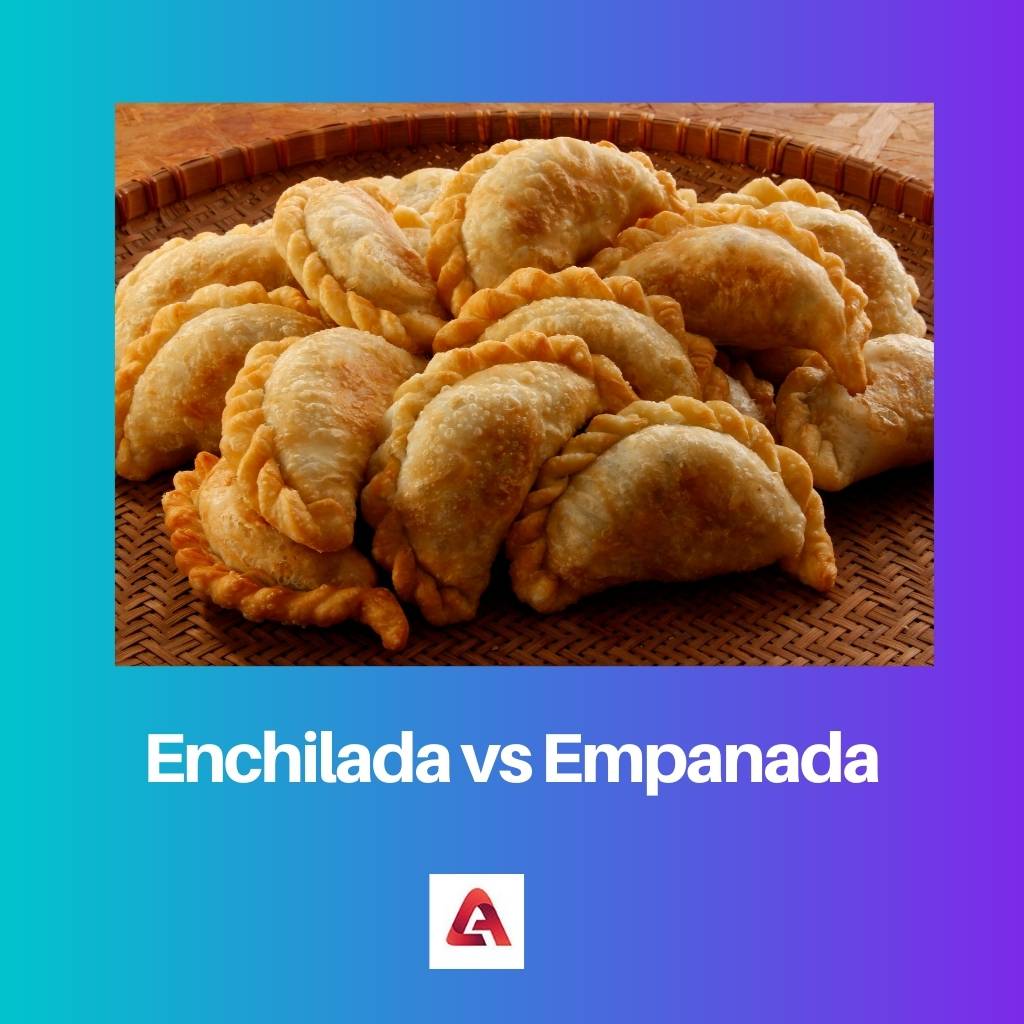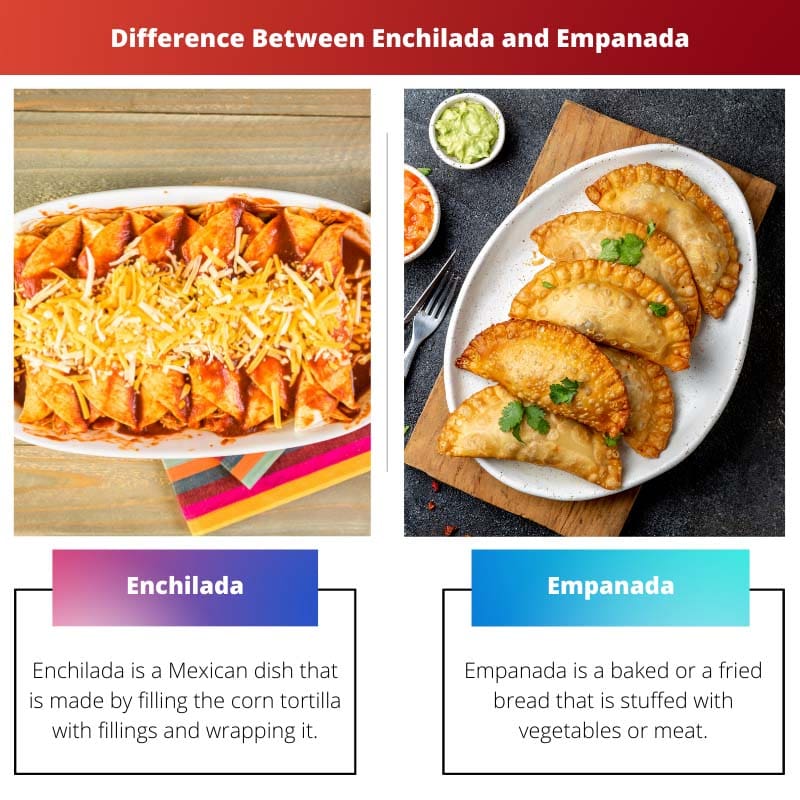Cuisines all over the world have a few delicious food items. Palm stuffed sandwiches to casserole-fried burritos, and the varieties make a man dazzle to taste. The healthy food items with delectable taste make a good combination as well.
Many dishes traversed times on this earth. Though the procedure to make and the equipment used to make it would have changed, the dishes stand by the traditional taste.
Two of the prime food items from different parts of the world have gained prominence solely because of their taste; Enchilada and Empanada. There are a few differences between them apart from the place of origin.
Key Takeaways
- Enchiladas are a Mexican dish made of rolled tortillas filled with meat, cheese, or vegetables and covered in sauce, while empanadas are a pastry filled with meat, cheese, or vegetables and baked or fried.
- Enchiladas are served as a main dish, while empanadas are served as a snack or appetizer.
- Enchiladas are made with tortillas, while empanadas are made with pastry dough.
Enchilada vs Empanada
The difference between Enchilada and Empanada lies in the way the dish is made. Enchilada is like a roll, where a corn tortilla is used to wrap on a variety of fillings. However, Empanada is made by baking or frying the dough that is stuffed with vegetables, fruits, or meat. Ideally, Enchilada is easy to make, while empanada requires professional help.

Enchilada is a traditional Mexican food item made by filling a corn tortilla with vegetables, meat, and combinations of the same. It is savoury and served with sauce. It is a dish that is considered a part of the main course. In the past, the dish was just an empty corn tortilla dipped in chilly sauce.
Empanada is a European Dish made by frying or baking the dough, which is stuffed with ingredients depending on the taste. It is served as sweet and savoury. You can add vegetables or even meat to make it delicious. At the same time, it is made as a pie while you use the fruits.
Comparison Table
| Parameters of Comparison | Enchilada | Empanada |
|---|---|---|
| Place of Origin | Mexico | Spain and Portugal |
| Preparation time | It is relatively quick to make Enchiladas. | It takes time as one might have to Knead, bake or fry the dough. |
| Meal Course | Essentially a Main Course | It is served as an appetizer and also during breakfast in a few countries. |
| Type | Savoury | Sweet and Savory |
| Health factor | Corn is the best fibrous food item. It aids in weight loss yet a filling dish. | The baking dish is healthy, but the fried one is not. |
What is Enchilada?
Enchilada is a Mexican dish that is made by filling the corn tortilla with fillings and wrapping it. It is served with Enchilada sauce and tastes excellent as a quick snack. The filling can range from vegetables to meat as well. The combinations of beans, cheese, and potatoes make a good filling for Enchilada.
Enchilada is a traditional dish from Mexico and has a very long history. Some documents proclaim that the Enchiladas have been in existence since 1300AD. People used to eat corn tortilla-wrapped food as a one-time meal.
Though it has an ancient presence, the modern Enchiladas still retain the same nutritious aspect. You can customize the dish to your preference. The changes can be made to the filling and can be had hot to get the best taste.
The filling can be multiple ingredients, but the ones with rice and beans are considered satisfying. A few people eat Enchiladas for the add-ons that come along with that. The toppings, such as
- Sour Cream
- Cilantro
- Green Onions and Chillies
- Sauce and much more
Are added to the dish. It is ideally very easy to cook the dish and consumes very little time. These days there are varieties of Enchilada and that differs from nation to nation.

What is Empanada?
Empanada is a baked or fried bread that is stuffed with vegetables or meat. Empanada falls under the category of pastries, and it comes in both sweet as well as savoury. It originated in Spain and Portugal, and its history dates back to the 1500s.
Generally, the dish is made by wrapping the dough over a combination of vegetables, fruits, or even meat. The wrapped dough is not baked or fried. In the past, empanadas were made in huge sizes and then served a portion of it.
It is considered an appetizer during a meal, while it is also treated as the main course in certain countries. Back then, seafood was stuffed in the bread, and nowadays, it contains a variety of ingredients. The cooking time is more and needs professional help in making Empanadas.
Though a few countries treat this food as an add-on, it was initially used as a main course dish. It was indeed filling as it contained a lot of stuffed items in it. Moreover, it was considered a working man’s lunch, and it was easy to carry as well.
Colombia and Argentina are the best makers of Empanada even now. Baked empanadas are easy to make as you can bake the entire dough at once. At the same time, fried empanadas do not taste as good as baked ones.

Main Differences Between Enchilada and Empanada
- The main difference between Enchilada and Empanada is the method of preparation. The former is made by gently wrapping corn tortilla over the desired ingredients, while Empanada is made by baking or frying the dough.
- Enchilada is a Mexican dish, while Empanada hails from Spain.
- Enchilada is very easy to make as it just requires you to wrap the ingredients and serve, while Empanada takes a longer time as you have to either fry or cook.
- Enchilada is always made as a single piece, and that depends on the size of the tortilla. But, Empanadas are made in big sizes and then cut into pieces while serving.
- Enchilada is not only filling when it is wrapped with rice. At the same time, it is a healthy dish, while Empanadas are a party dish and not as healthy as the Mexican dish.

- https://books.google.co.in/books?hl=en&lr=&id=tH-4CgAAQBAJ&oi=fnd&pg=PR15&dq=Enchilada+vs+Empanada&ots=zglSx39iSE&sig=t2RVDIxkHsgAUPfQILyV4h5K4dI&redir_esc=y#v=onepage&q=Enchilada%20vs%20Empanada&f=false
- https://krishikosh.egranth.ac.in/handle/1/82290

The comparison table provides a clear insight into the unique characteristics of Enchiladas and Empanadas. It’s a great reference for differentiating between the two dishes.
The historical perspective of these two dishes is quite intriguing. It’s fascinating to look at how the culinary history of these dishes goes back centuries.
The historical origins of Enchiladas and Empanadas provide valuable insights into the interplay of cultural, geographical, and historical factors that have shaped these culinary delights.
Absolutely, understanding the historical and cultural context of these dishes enhances our appreciation for the culinary diversity and traditions across the globe.
The detailed description of the ingredients and fillings used in both Enchiladas and Empanadas emphasizes the diverse culinary creations that have become popular over time.
Indeed, the diverse range of ingredients and culinary techniques used in making these dishes is truly remarkable.
The distinction between the health factors of Enchiladas and Empanadas is quite noteworthy. It reflects the cultural and regional influences on the dietary preferences of different cuisines.
The description of the historical and cultural contexts behind the development of Enchiladas and Empanadas provides a compelling narrative of the culinary traditions that have transcended time and geography.
Indeed, the intricate details of the cultural and historical roots of these dishes underscore the rich and diverse tapestry of global cuisine.
The historical and cultural underpinnings of Enchiladas and Empanadas provide a fascinating window into the intertwined narratives of culinary traditions across different regions.
The comparative analysis of the culinary characteristics and cultural influences of both Enchiladas and Empanadas offers deep insights into the historical and geographical diversity of traditional cuisines.
Indeed, the culinary evolution of these traditional dishes reflects the shared history and distinctive cultural expressions found in global cuisines.
The historical documentation and evolution of the ingredients and cooking techniques used in both Enchiladas and Empanadas reflect the blending of traditional and contemporary culinary practices.
Absolutely, the convergence of diverse cultural influences in these traditional dishes highlights the global nature of culinary creativity and innovation.
The historical evolution and cultural influences on the culinary traditions of both Mexican and European cuisines are beautifully captured in the descriptions of Enchiladas and Empanadas.
Absolutely, the rich and diverse culinary heritage of different regions across the world is showcased through these beloved traditional dishes.
The adaptability and variations in the ingredients used in both dishes reflect the culinary creativity and innovation present in traditional cuisines.
The traditional values associated with both Enchiladas and Empanadas highlight the rich cultural heritage linked to the culinary arts.
Absolutely, the cultural significance and historical roots of these dishes add a layer of depth to their already rich flavors.
The historical timelines and cultural influences that have contributed to the development of Enchiladas and Empanadas reflect the richness of global culinary heritage.
The meticulous exploration of the historical origins and culinary characteristics of these dishes deepens our understanding of the global culinary tapestry.